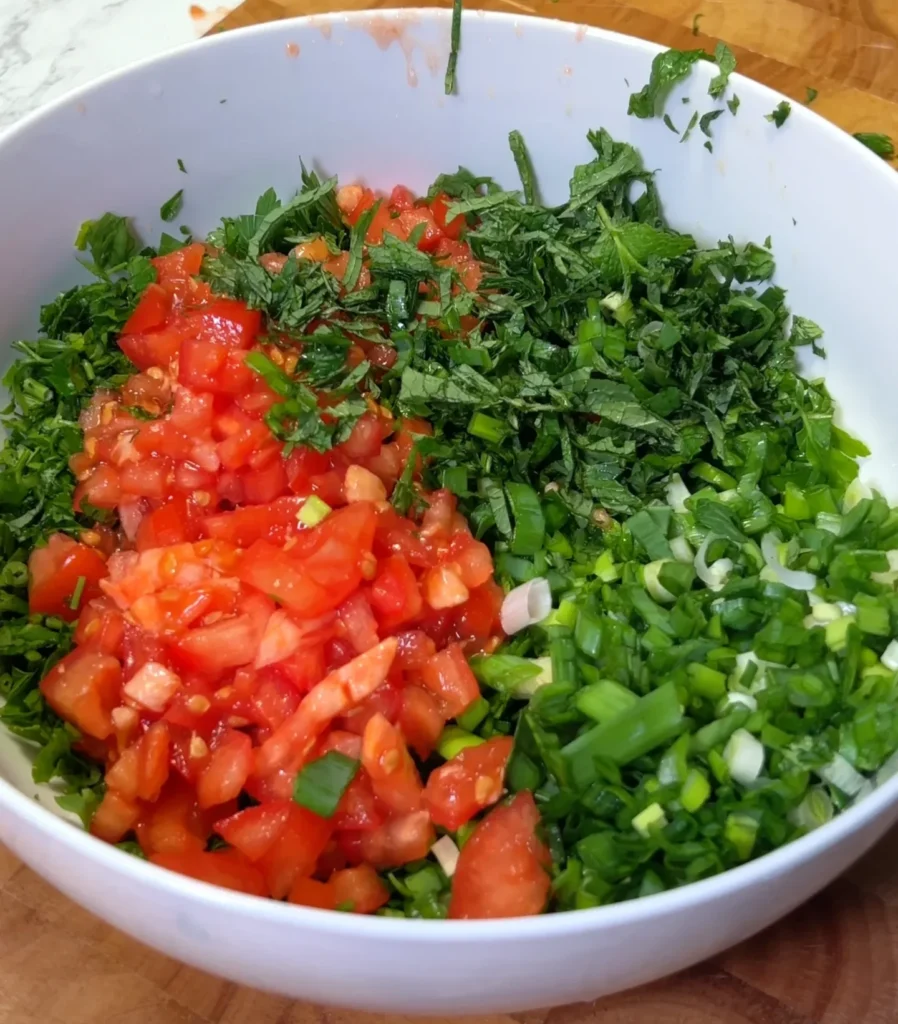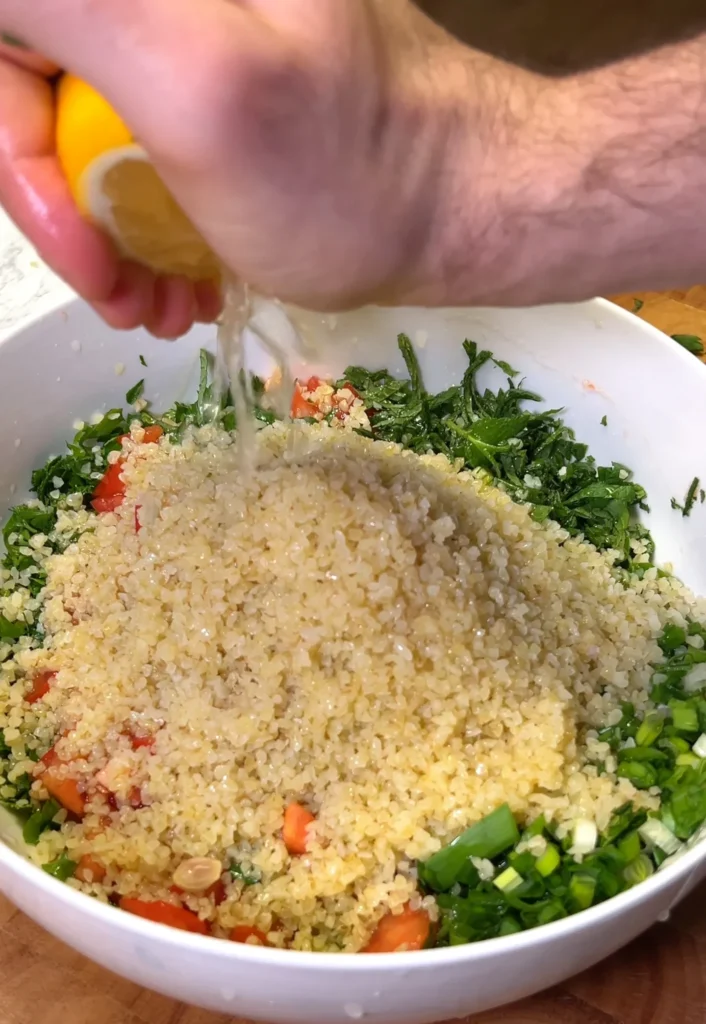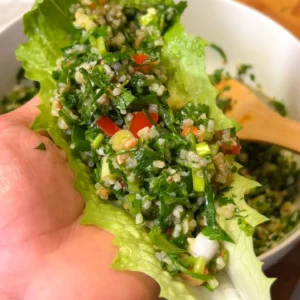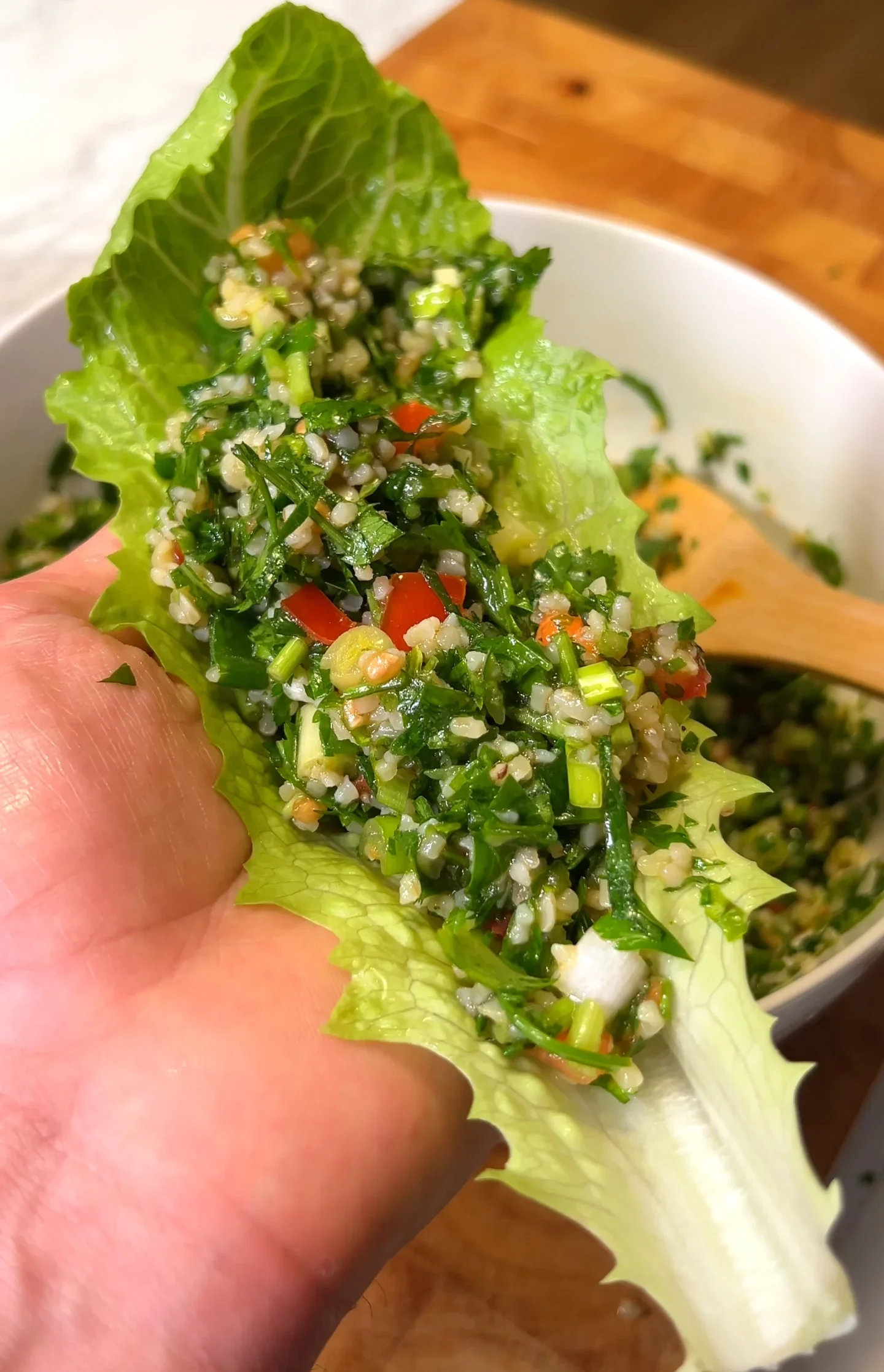Tabbouleh, a traditional Middle Eastern salad, is known for its simplicity, vibrant flavors, and healthful ingredients. Originating from the mountainous regions of Lebanon and Syria, this dish has traversed the globe, earning its place in the hearts of many.
The Ingredients
- Fine Bulgur: A cornerstone of Tabbouleh, bulgur wheat is a type of whole grain made from dried, cracked wheat. It’s known for its nutty flavor and quick cooking time. In Tabbouleh, bulgur acts as a sponge, absorbing flavors from other ingredients, providing a subtle, chewy texture that contrasts with the crispness of the vegetables.
- Fresh Parsley: The soul of Tabbouleh lies in parsley. This herb is not just a garnish in this dish; it’s the main ingredient. Parsley adds a burst of freshness, color, and a slightly peppery flavor to the salad. Traditionally, flat-leaf parsley is used for its more pronounced flavor, but curly parsley can also be employed for a more textured appearance.
- Tomatoes and Spring Onions: These add not only a splash of color but also an array of flavors and textures. Tomatoes offer juiciness and a slight acidity, while spring onions provide a mild, crunchy bite.
- Dressing: The combination of extra virgin olive oil and fresh lemon juice creates a dressing that is both simple and transformative. The olive oil provides a silky texture and richness, while the lemon juice brings a bright, citrusy tang.
Preparing the Tabbouleh
- Soaking the Bulgur: Start by soaking the bulgur in hot water. This process softens the grains, making them tender and plump. It’s crucial not to over-soak, as maintaining some texture is key to a good Tabbouleh.

- Chopping the Vegetables: Tabbouleh is known for its fine chop. The parsley, tomatoes, and onions should be diced as finely as possible. This not only contributes to the aesthetic but also ensures that every bite is a harmonious blend of all the ingredients.

- Combining Ingredients: After chopping, combine these vegetables with the bulgur. This step is about gently mixing to ensure the flavors are well-distributed without crushing the delicate ingredients.

- Seasoning and Marinating: The dressing is simple yet crucial. Drizzle the salad with olive oil and lemon juice, then season with salt and pepper. After mixing, let the Tabbouleh rest. This resting period allows the flavors to meld together, with the bulgur soaking up the dressing and herbs, creating a harmonious blend.

- Final Taste and Adjustment: Before serving, give the Tabbouleh a final taste. Adjust the seasoning or lemon juice as needed. This is where you can tailor the salad to your preference, ensuring the right balance of tangy, salty, and herby flavors.

Cultural Significance and Variations
Tabbouleh holds a special place in Middle Eastern cuisine. It’s often served as part of a Mezze, a selection of small dishes served at the beginning of a meal. This salad is more than just a dish; it’s a representation of the region’s culinary history and its reliance on fresh, locally sourced ingredients.
While the traditional recipe is revered, variations do exist. Some add mint for an extra layer of freshness, while others might include cucumber for added crunch. The choice of bulgur can also vary, with some preferring finer grains over coarser ones.
Tips for the Perfect Tabbouleh
- Ingredient Quality: The simplicity of Tabbouleh means the quality of each ingredient is paramount. Use the freshest parsley and ripest tomatoes you can find.
- Balancing Flavors: The key to a great Tabbouleh is balance. The tartness of the lemon, the earthiness of the bulgur, the freshness of the parsley, and the richness of the olive oil should all be in harmony.
- Texture: Aim for a salad that’s moist but not soggy. The bulgur should be tender but not mushy, and the vegetables should retain some crispness.
Serving Suggestions
Tabbouleh is ideally served chilled or at room temperature. Its versatility allows it to pair beautifully with a variety of dishes. It is a staple in the Mediterranean and Middle Eastern diets and complements many vegetarian and vegan options wonderfully:
- With Falafel: The crispness of falafel juxtaposed with the fresh, herby Tabbouleh creates a delightful combination.
- As Part of Mezze: In a traditional Middle Eastern Mezze, Tabbouleh can be served alongside other vegetarian dishes like hummus, baba ganoush, and stuffed grape leaves.
- With Grilled Vegetables: The freshness of the salad complements the charred flavor of grilled vegetables like zucchini, eggplant, and bell peppers.
- As a Standalone Dish: Tabbouleh can also be enjoyed on its own, as a light and refreshing meal, especially during warmer months.
- With Pita Bread: Scooping Tabbouleh with warm, soft pita bread is a classic way to enjoy this dish.
Regardless of how you choose to serve it, Tabbouleh brings a refreshing, herby, and healthy option to any meal, particularly for those following a vegetarian or vegan diet. Its ease of preparation and delightful flavor profile make it a go-to choice for both everyday meals and special occasions.

Tabbouleh
Equipment
- Large mixing bowl
- Chopping board
- Knife
- Fork
Ingredients
- 1/2 cup fine bulgur about 85g
- 1/2 cup hot water 170ml
- 3 cups fresh parsley, finely chopped about 360g
- 1 cup tomato, finely diced about 180g
- 1/2 cup spring onion, finely chopped about 50g
- 1/3 cup extra virgin olive oil about 80ml
- Salt and black pepper to taste
- 1 Juice of 1 lemon
Instructions
- Prepare the Bulgur: In a large bowl, soak the bulgur in hot water. Cover and let it sit for about 15 minutes until soft. Fluff it up with a fork afterwards.
- Chop the Veggies: Finely chop the parsley, tomato, and spring onion.
- Combine: Add the chopped vegetables to the bulgur and toss gently.
- Season: Drizzle with olive oil, and add the fresh lemon juice. Season with salt and pepper. Mix well.
- Marinate: Let the tabbouleh sit for about 30 minutes to allow the flavors to meld.
- Taste and Adjust: Give it a final taste test and adjust the seasoning or lemon juice if needed.
- Serve: Enjoy your tabbouleh chilled or at room temperature.
Video
Notes
Store refrigerated and consume within 2 days.
